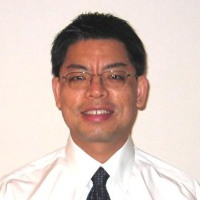Topic: Interface-based memory and field effect devices made of complex oxides: an emerging game of oxide electronics
Speaker: Dr. Tom Wu
Abstract:
The rich physics in complex oxides as a result of strong correlations between charge, spin, orbital and lattice produces novel collective electronic states, such as high-temperature superconductivity and colossal magnetoresistance. In epitaxial heterostructures, we can explore even more opportunities due to the emergent interface-based phenomena based on charge transfer, spin exchange, ionic migration and so on. At the same time, unraveling the physics in such quantum materials requires theoretical insights as well as novel synthesis with precision on the unit cell level. In this talk, I will first discuss the recent efforts in my group of building interface-based nonvolatile resistive switching device in “digitally” synthesized heterostructures of LaAlO3 (LAO) and SrTiO3 (STO) grown using laser MBE. Our experiments and first-principles calculations suggest a unique mechanism: the alteration of the electronic configuration and the creation of gap states within the LAO layer underpin the memory operation. Then I will discuss our very recent results on the interface-based field effect device with a double layer ionic electrolyte as the top gate. These results shed lights on the possible manifestations of Kondo effect and 2D insulator-to-metal transition at the oxide interfaces. In this emerging game of complex oxides, future research efforts with accelerated intensity are clearly needed to realize interface-based oxide nanoelectronics involving strongly correlated electrons.
Speaker:
 Dr. Wu received his B.S. from Zhejing University in 1995 and Ph.D. from the University of Maryland, College Park in 2002. After working as a postdoc in Argonne National Laboratory, in Materials Science Division and Center for Nanoscale Materials, he joined the faculty of Nanyang Technological University in 2006. Dr. Wu has authored/co-authored more than 100 papers and gave about 50 invited talks worldwide. He is the regular reviewer for almost all major journals in the fields of physics, materials science, and chemistry. His research group focuses on designing and synthesizing oxide thin films, nanomaterials and heteostructures, exploring their emergent physical properties, and fabricating novel devices in the areas of spintronics, multiferroics, resistive switching memory, and field effect transistors. More information can be found at http://www1.spms.ntu.edu.sg/~tomwu/index.htm.
Dr. Wu received his B.S. from Zhejing University in 1995 and Ph.D. from the University of Maryland, College Park in 2002. After working as a postdoc in Argonne National Laboratory, in Materials Science Division and Center for Nanoscale Materials, he joined the faculty of Nanyang Technological University in 2006. Dr. Wu has authored/co-authored more than 100 papers and gave about 50 invited talks worldwide. He is the regular reviewer for almost all major journals in the fields of physics, materials science, and chemistry. His research group focuses on designing and synthesizing oxide thin films, nanomaterials and heteostructures, exploring their emergent physical properties, and fabricating novel devices in the areas of spintronics, multiferroics, resistive switching memory, and field effect transistors. More information can be found at http://www1.spms.ntu.edu.sg/~tomwu/index.htm.



